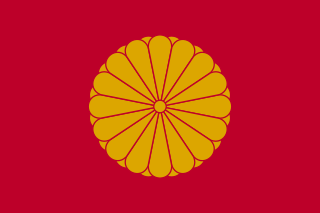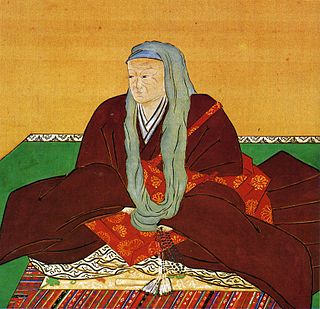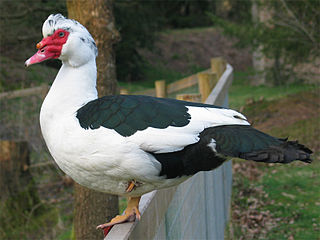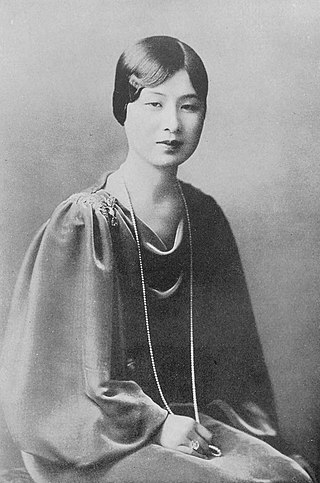
The Emperor of Japan is the figurehead monarch and the head of the Imperial House of Japan. Under the Constitution of Japan, he is defined as the symbol of the Japanese state and the unity of the Japanese people, and his position is derived from "the will of the people with whom resides sovereign power". Imperial Household Law governs the line of imperial succession. The emperor is immune from prosecution by the Supreme Court of Japan. He is also the head of the Shinto religion. In Japanese, the emperor is called Tennō, literally "Emperor of heaven" or "Heavenly Sovereign". The Japanese Shinto religion holds him to be the direct descendant of the sun goddess Amaterasu.

Emperor Reigen was the 112th emperor of Japan, according to the traditional order of succession. Reigen's reign spanned the years from 1663 through 1687.

The mallard or wild duck is a dabbling duck that breeds throughout the temperate and subtropical Americas, Eurasia, and North Africa. It has been introduced to New Zealand, Australia, Peru, Brazil, Uruguay, Argentina, Chile, Colombia, the Falkland Islands, and South Africa. This duck belongs to the subfamily Anatinae of the waterfowl family Anatidae. Males have green heads, while the females have mainly brown-speckled plumage. Both sexes have an area of white-bordered black or iridescent purple or blue feathers called a speculum on their wings; males especially tend to have blue speculum feathers. The mallard is 50–65 cm (20–26 in) long, of which the body makes up around two-thirds the length. The wingspan is 81–98 cm (32–39 in) and the bill is 4.4 to 6.1 cm long. It is often slightly heavier than most other dabbling ducks, weighing 0.7–1.6 kg (1.5–3.5 lb). Mallards live in wetlands, eat water plants and small animals, and are social animals preferring to congregate in groups or flocks of varying sizes.

The ring-necked duck is a diving duck from North America commonly found in freshwater ponds and lakes. The scientific name is derived from Greek aithuia, an unidentified seabird mentioned by authors including Hesychius and Aristotle, and Latin collaris, "of the neck" from collum, "neck".

Peking duck is a dish from Beijing (Peking) that has been prepared since the Imperial era. The meat is characterized by its thin, crispy skin, with authentic versions of the dish serving mostly the skin and little meat, sliced in front of the diners by the cook. Ducks bred especially for the dish are slaughtered after 65 days and seasoned before being roasted in a closed or hung oven. The meat is often eaten with spring onion, cucumber and sweet bean sauce with pancakes rolled around the fillings. Sometimes pickled radish is also inside. Crispy aromatic duck is a similar dish to Peking duck and is popular in the United Kingdom.

The Muscovy duck is a duck native to the Americas, from the Rio Grande Valley of Texas and Mexico south to Argentina and Uruguay. Feral Muscovy ducks are found in New Zealand, Australia, and in Central and Eastern Europe. Small wild and feral breeding populations have also established themselves in the United States, particularly in Florida, Louisiana, Massachusetts, the Big Island of Hawaii, as well as in many other parts of North America, including southern Canada.

The Imperial Household Agency (IHA) is an agency of the government of Japan in charge of state matters concerning the Imperial Family, and also the keeping of the Privy Seal and State Seal of Japan. From around the 8th century AD, up until the Second World War, it was known as the Imperial Household Ministry.

The white-winged duck or white-winged wood duck is a large species of duck, formerly placed in the genus Cairina with the Muscovy duck and allied with the dabbling ducks. However, mtDNA cytochrome b and NADH dehydrogenase subunit 2 sequence analysis indicate that the anatomical similarity to the Muscovy duck is deceiving and that the species is appropriately placed in a monotypic genus, as Asarcornis scutulata, which is evolutionarily closer to the redhead.
Takagari is Japanese falconry, a sport of the noble class, and a symbol of their nobility, their status, and their warrior spirit.

Chikako, Princess Kazu (Kazunomiya) was the wife of 14th shōgun Tokugawa Iemochi. She was renamed Lady Seikan'in-no-miya after she took the tonsure as a widow. Chikako was the youngest child of Emperor Ninkō.

Kikuko, Princess Takamatsu, born Kikuko Tokugawa, was a member of the Japanese imperial family. The Princess was married to Nobuhito, Prince Takamatsu, the third son of Emperor Taishō and Empress Teimei. She was, therefore, a sister-in-law of Emperor Shōwa and an aunt by marriage of the following emperor, Akihito. She was mainly known for philanthropic activities, particular her patronage of cancer research organizations. At the time of her death, Princess Takamatsu was the oldest member of the Imperial Family.

Setsuko, Princess Chichibu was a member of the Japanese imperial family and the wife of Yasuhito, Prince Chichibu, the second son of Emperor Taishō and Empress Teimei. Setsuko was a sister-in-law of Emperor Shōwa and an aunt by marriage of Emperor Akihito.

Hanako, Princess Hitachi, is a member of the Japanese Imperial Family as the wife of Masahito, Prince Hitachi, who is the younger son of Emperor Shōwa and the only brother of Emperor Emeritus Akihito.

Hama-rikyū Gardens is a metropolitan garden in Chūō ward, Tokyo, Japan. Located at the mouth of the Sumida River, it was opened to the public on April 1, 1946. A landscaped garden of 250,216 m² includes Shioiri-no-ike, and the garden is surrounded by a seawater moat filled by Tokyo Bay. It was remodeled as a public garden on the site of a villa belonging to the ruling Tokugawa family in the 17th century.

The Imperial House, also referred to as the Imperial Family and the House of Yamato, is the royal family of Japan, consisting of those members of the extended family of the reigning Emperor of Japan who undertake official and public duties. Under the present Constitution of Japan, the Emperor is "the symbol of the State and of the unity of the people". Other members of the Imperial Family perform ceremonial and social duties, but have no role in the affairs of government. The duties as an Emperor are passed down the line to their male children. This Japanese monarchy is the oldest continuous hereditary monarchy in the world. The Imperial House recognizes 126 monarchs, beginning with Emperor Jimmu, and continuing up to the current emperor, Naruhito. However, scholars have agreed that there is no evidence of Jimmu's existence, that the traditional narrative of Japan's founding is mythical, and that Jimmu is a mythical figure. Historical evidence for the first 25 emperors is mythical, but there is sufficient evidence of an unbroken hereditary line since the early 6th century. Historically verifiable Emperors of Japan start from AD 539 with Emperor Kinmei.

Waterfowl hunting is the practice of hunting ducks, geese, or other waterfowl for food and sport.

Shiodome is an area in Minato, Tokyo, Japan, located adjacent to Shinbashi and Ginza, near Tokyo Bay and the Hamarikyu Gardens. Formerly a railway terminal, Shiodome has been transformed into one of Tokyo's most modern areas. It is a collection of 11 tiny town districts or cooperative zones, but generally there are three main areas:

The Call is a historic breed of small domestic duck. It is believed to have originated in the Netherlands, where the earliest descriptions and depictions of it date from the seventeenth century. It is similar in appearance to some other breeds of duck, but is much smaller, with a round head and very short bill. Ducks, but not drakes, are very loquacious and noisy, with a piercing high-pitched call which be heard from far away.

A duck decoy is a device to capture wild ducks or other species of waterfowl. Decoys had an advantage over hunting ducks with shotguns as the duck meat did not contain lead shot. Consequently, a higher price could be charged for it.
The Board of Ceremonies is a department of the Imperial Household Agency of Japan. The board is the chief administration charged with ceremonial matters.





















